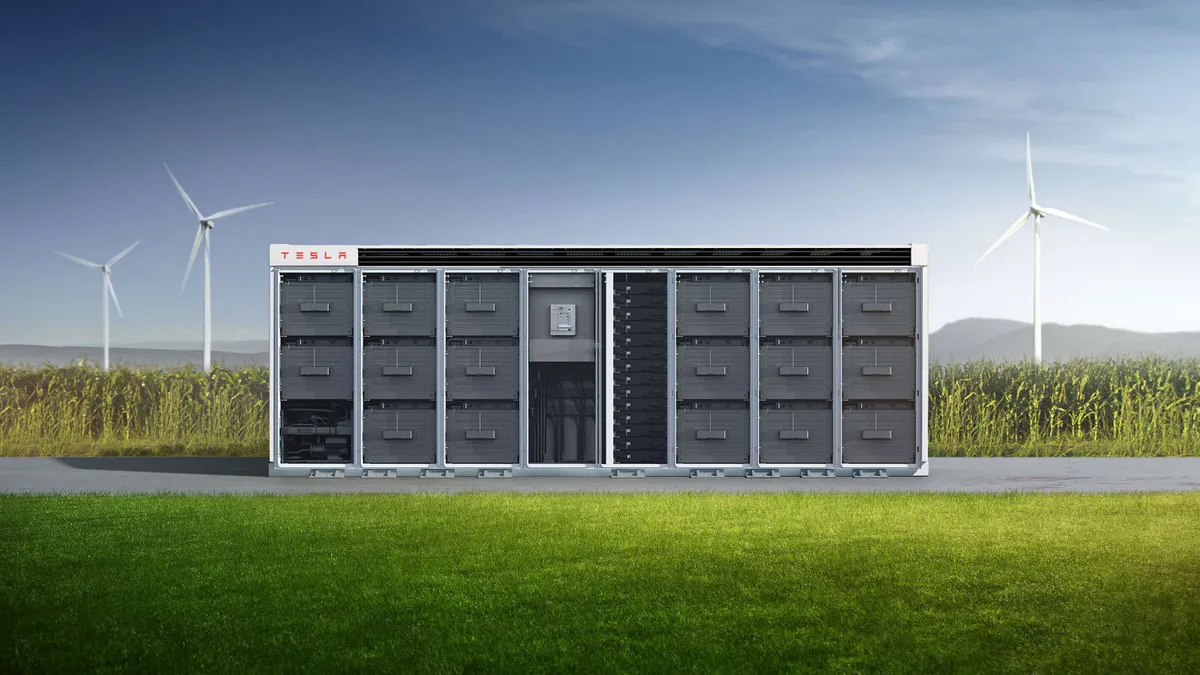Dive Brief:
- Tesla is switching to lithium iron phosphate (LFP) battery cells for its utility-scale Megapack energy storage product, a move that analysts say could signal a broader shift for the energy storage industry.
- Costs for LFP batteries have dropped in recent years, although they have historically cost more to produce than other lithium-based chemistries. LFP batteries do not use cobalt, a critical mineral that can be expensive, and tend to have a lower fire risk than more conventional lithium-nickel-manganese-cobalt-oxide (NMC) batteries.
- Reuters reported last week that Tesla is also in talks to partner with Chinese LFP battery manufacturer EVE Energy to add to its supply chain, a move that could drop the price of the chemistry even further.
Dive Insight:
In the company’s first quarter earnings call last month, Tesla executives talked up their energy storage business arm, saying they saw it as important as their vehicle sales. The 3 MWh per unit Megapack product is advertised as a sustainable alternative to peaker plants and Tesla says it could deploy a 250 MW, 1 GWh power plant on a three-acre footprint with the product.
CEO Elon Musk said that increasing battery storage for both residential customers and utilities was a "long-term solution to the sustainable energy future." Musk also noted that, compared to its Powerwall residential storage product, the larger Megapack unit still needed work to make it more cost efficient but that there was a "clear runway" for improving costs. In the same call, Musk said the "vast majority of stationary storage" would be iron-based lithium-ion cells, despite the lower energy density.
Analysts have predicted that the storage sector could lean more on LFP chemistry as production costs drop, despite the lower energy density of the product. An August 2020 Wood Mackenzie report predicted that LFP batteries could overtake NMC batteries for storage applications by 2030, growing from 10% of the market in 2015 to more than 30% by 2030. A separate report from Roskill notes that Chinese safety standards for electric vehicles, along with supply chain constraints for NMC materials, could boost LFP batteries for vehicles.
Tesla already relies on LFP chemistry for its Model 3 vehicles and indicated at last fall’s Battery Day that it would do the same for stationary storage. Despite their lower material cost, the lower density of LFP batteries presents a challenge for vehicle applications because they can limit vehicle range. That is less of a concern for stationary storage, especially for larger utility-scale projects, explained Matthew Keyser, manager of the electrochemical energy storage group at the National Renewable Energy Laboratory.
"In vehicles, you need that small mass and small volume for batteries, but it’s just not as critical for storage," Keyser said. "You can put the batteries in a container, a storage shed, out in a field somewhere and not have to think about volume."
LFP batteries also have a safety advantage, because they require more heat to reach thermal runaway, when a failing battery cell heats up and triggers a chain reaction that can lead to an explosion. That’s led some storage providers to look to LFP as a solution; integrator Powin Energy, for example, says it uses only LFP for safety reasons and home energy storage producer Electriq Power announced in November its Power Pod 2 home storage system would use LFP batteries, which it said are "rapidly becoming the industry standard."
Hanjiro Ambrose, a postdoctoral researcher at the University of California, Davis, said the move was positive "because it's going to reduce the demand for cobalt for batteries, which will help make sure there's not a significant environmental impact and not create barriers to electrification." Overall, he said, the shift could lower costs for Megapack customers, but also signaled "there's still a lot of opportunity for change" in the lithium-ion battery industry.













